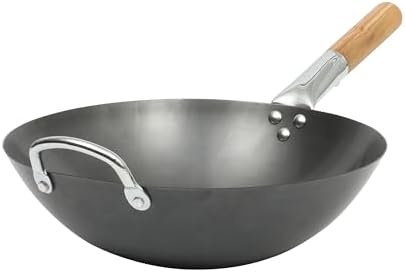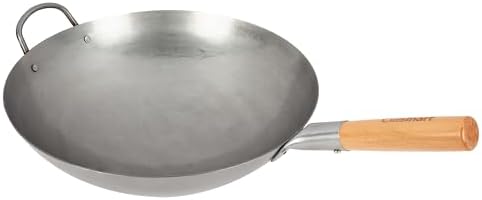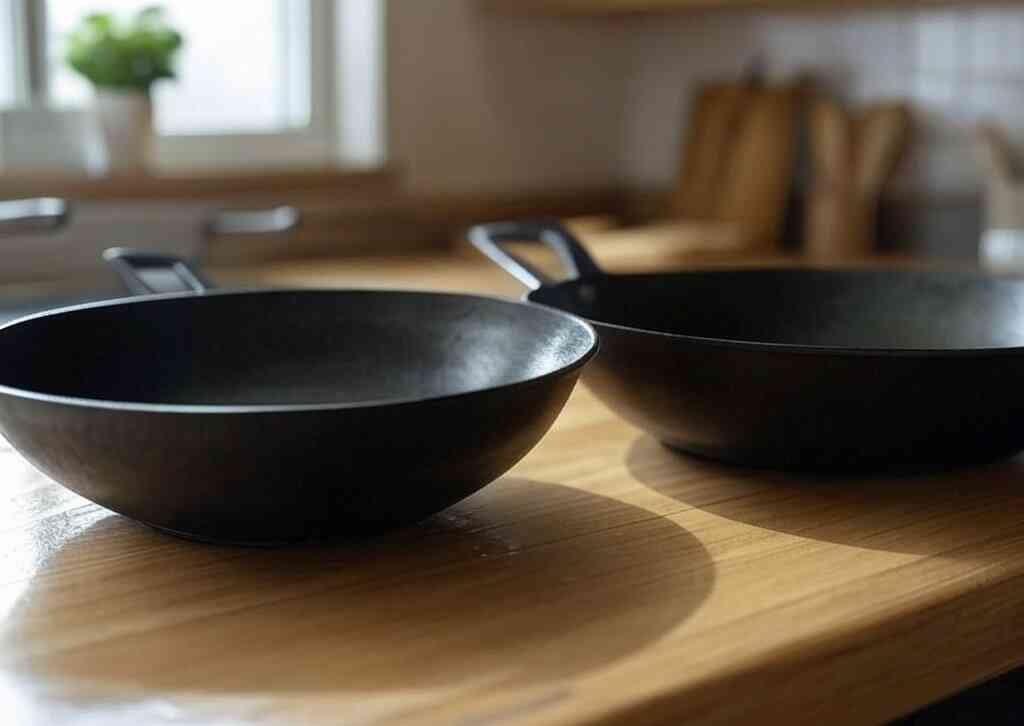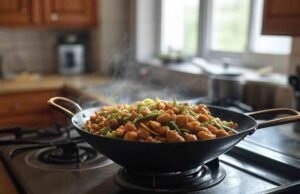Introduction to Wok Cooking
The versatile and indispensable cooking pan, wok holds a very prominent place in the culinary culture of many. Particularly in Asian cooking. Since its inception in old China, the wok has been a part of everyday cooking for thousands of years. The high-sided round bottom of the wok makes it possible to cook in many different ways. Ensuring uniform heat transfer and precise temperature control. It possesses this unique shape which allows for speedy cooking methods such as stir-frying. Steaming, and deep-frying, hence showing its adaptability in the kitchen.
Dating back over two thousand years, wok usage is found in ancient Chinese home cookbooks and household ledgers. Because of its practicality and efficiency, it gained popularity with both domestic cooks and professional chefs. The wok’s popularity has changed over the years and across cultures, as taken up by various culinary cultures around the globe. Including Thai and Vietnamese, Indian, and numerous others.
One of the benefits of wok cooking is that food can be quickly cooked while flavor and nutrients are preserved. Splattering is avoided by the sidewalls of the wok, and tossing food without spilling is allowed. This feature not only makes it most appropriate for stir-frying but also facilitates techniques such as steaming. Food can be placed in a bamboo steamer placed over the wok for slow cooking. Deep frying is also done well using a wok since its shape makes it possible to use less oil compared to regular frying pans. The wok’s versatility thus makes it a focal piece of equipment in professional and domestic kitchens. Complement to anyone looking to increase their repertoire of food choices.
Speed Cooking: The Speed Advantage
The shape of the wok, possessing the unusual concave form and large surface area, is an excellent tool in speed cooking. Stovetop cooking is usually performed on flat surfaces that could restrict the rapid transfer of heat. The wok, however, is designed for rapid heating, with the curved bottom concentrating heat at the bottom and providing sufficient space to stir and toss food. The design allows for even heat distribution, which consequently minimizes cooking time and accelerates cooking food.
In addition, the steep sides of a wok allow for easy tossing and stirring of ingredients. Ensuring a fast sear on meat and vegetables while locking in their flavor and nutritional value. This method, referred to as stir-frying, induces minimal cooking time along with intense heat, resulting in rapid caramelization and sealing of flavors. When quickly stir-fried in a wok, vegetables are able to preserve their colour, crisp texture, and essential vitamins, making it a healthy choice for those that prefer to prepare healthy meals quickly.
The convenience of wok cooking is particularly beneficial in busy kitchens, where time is of the essence. Home chefs and even working chefs can prepare excellent dishes in a matter of minutes, which means less time on the stovetop and more time to enjoy the finished dish. That efficiency is particularly beneficial when quick meal preparation is needed. Home chefs and professionals having a handy way to modern cooking.
Generally speaking, the innovative design of a wok optimizes cooking time as well as enhances the entire culinary experience, and it is an extremely convenient utensil for any person who wishes to enhance the efficiency of cooking.
Even Heat Distribution: Cooking Consistency
Even heat distribution is an important cooking aspect that is very important in deciding the quality and consistency of cooked foods. A wok, because of its shape and material, is particularly suited to efficiently distribute heat across food during cooking. The traditional woks, usually made from carbon steel or cast iron, have high thermal conductivity, which allows them to heat up nearly instantly and distribute themselves evenly. The concave nature of a wok once more has the effect of facilitating heat to travel more easily around the surface.
One of the most important advantages of a wok is its ability to generate high cooking temperatures with consistency. This is required for techniques such as stir-frying, where rapid cooking prevents foods from becoming soggy and builds up a good texture and flavor. Hot spots, which lead to uneven cooking and yucky results, are minimized through the shape of the wok. After adding food to the pan, it should ensure the heat is distributed evenly in order not to overcook some sections and leave others undercooked.
Also, the use of good technique, such as frequent stirring and precise temperature management, can make the cooking process better. With the integration of these processes and a wok, professional-level outcomes can be achieved, duplicating the effectiveness of high-end kitchens. With the combination of the ideally designed cooking vessel and the utilization of good technique. The entire cooking experience is increased, as well as the depths of the flavor profiles for the food that is being prepared.
At its essence, even heat distribution not only ensures food is properly. Cooked but also provides an opportunity for home-based chef-quality outcomes. Therefore, investing in a good-quality wok can be a life-changing decision for any individual who wishes to upgrade the quality of cooking and benefit from the numerous advantages this single kitchen appliance has to offer.
Energy Efficiency: Reduced Energy Use
As far as efficient energy cooking is concerned, the wok is a great choice. The type of material and shape used in a wok make it efficient in terms of fast and even heat transfer. Leading to the attainment of higher temperatures at faster rates than the conventional cookware. This is a strongly needed facility in the present context where energy conservation is increasingly. Becoming important for environmental sustainability as well as for the household budget.
The shape of a wok, its shallow and wide basin, and sloping sides are all designed to provide the largest possible cooking surface exposed to heat. This enables rapid searing and stir-frying of food, which cooks faster, and consequently, less energy consumption. Moreover, the common material used to produce woks, e.g., carbon steel or cast iron, possesses high heat retention. Because the wok heats extremely well, amateur cooks know they can turn back the heat sooner than they could with the majority of frying pans or pots, providing additional savings in energy.
Using a wok for multifunctional cooking not only reduces reliance on electricity or fuel but also results in an eco-friendlier lifestyle. Homes and businesses that implement energy-saving practices add up to the overall effort of conserving the environment. In practical life, this energy conservation means reduced electricity or fuel bills. Over time and collectively, such savings can be considerable. Making the wok not just an omnifunctional kitchen tool but also a cost-saving investment for green-conscious cooks.
Overall, the energy efficiency of the wok essentially contributes to its appeal. With the synergistic effect from the unique design of the wok and material characteristics. Fantastic cooking results may be achieved by the users with minimal environmental pressure and conserved energy spending. This renders the wok a appealing choice for any person wishing to maximize cooking efficacy with consideration for the utilization of resources.












[…] produce the most versatility of the wok, you need the right tools: the wok spatula (chuan) and the wok ladle (hoak). Skill in knowing when […]
[…] Round-bottom woks were never intended for the flat glass of modern cooktops. Without the focused, intense heat of a gas burner, achieving true stir-fry results on an electric or induction stove requires a bridge. This is where the Wok Ring Electric Induction stand becomes indispensable. The right ring or stand solves the basic problem of stability and heat transfer that enables the proper centering and heating of the wok. […]